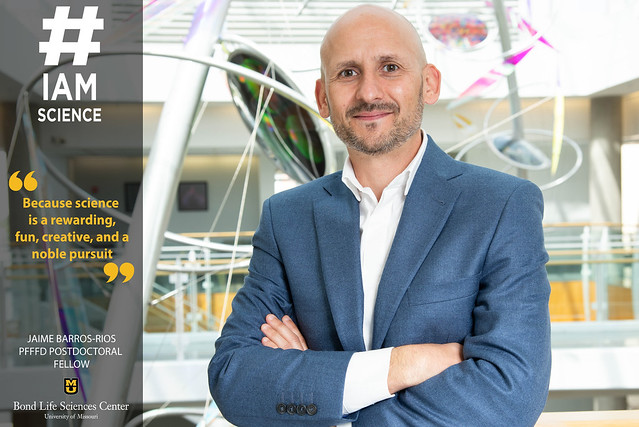Published on
By Cara Penquite | Bond LSC
When Jaime Barros-Rios explains his work to others, he says he studies how plants make wood.
All plants — from oaks down to daffodils and clovers — do, in fact, make wood …. or at least components of it.
That component is lignin, a functional unit of plant cell walls and wood. Barros-Rios studies it as he learns the ins and outs of research at Bond LSC in hopes of potentially holding a faculty position at MU as part of the Preparing Future Faculty – Faculty Diversity (PFFFD) postdoctoral program.
With a variety of science experience from cell biology to plant breeding and genomic approaches, Barros-Rios tackles his science from many angles.
“Usually in research we get better results when we combine different areas of knowledge,” Barros-Rios said.
He arrived in Columbia in August, now working closely with his faculty mentors Ron Mittler and Bing Yang. He combines expertise in metabolic engineering of plant cell wall pathways.
Plant cell walls have three major polymers — cellulose, hemi-cellulose, and lignin — which create the rigid cell wall unique to plants.
“Lignin is the second most abundant biopolymer on Earth, and we are interested in discovering and testing key genes and mechanisms underlying its biosynthesis for use in future breeding programs,” Barros-Rios said.
Barros-Rios grew up in the small town of Soutomaior in Galicia, Spain. He recalls his childhood in the rainy, lush-green town as a typical small-town kid playing with his friends.
“I have always had a deep fascination about the natural world. I love both plants and animals and I could see myself doing research in either area” Barros-Rios said.
Barros-Rios majored in forest engineering for his undergrad, a safe option with many job opportunities in one of Europe’s most forest-dense areas. Straight out of undergrad, he worked in a company managing forests for five years. He scheduled when to cut trees down and grow new ones to keep the forest productive.
“After five years, I saw that I have learned how to do most of the things that I was tasked with,” Barros-Rios said. “Science is not like that; you are always learning.”
Barros-Rios returned to the University of Vigo for his Ph.D. studies in plant breeding and genetics while continuing his work part-time. Despite his high school science teacher’s comments that he would not be good at chemistry, Barros-Rios pursued biochemistry.
“I think we’re all very smart as humans, so if we are committed enough we can find our way through,’” Barros-Rios said.
During his Ph.D. he worked for the Spanish National Research Council and started presenting his research at international conferences. He spent time in Sweden and Texas during his postdoctoral studies before coming to MU.
“I was fortunate to experience working in Rick Dixon’s lab at the University of North Texas,” Barros-Rios said. “This really helped me get my research program started.”
Barros-Rios hopes to continue learning and growing through the PFFFD postdoctoral program, but his short-term goal is to fund his own research.
“I have plans to get my own research program off the ground and funded here at Mizzou,” Barros-Rios said.
His previous research publications as a corresponding author show his scientific independence, but Barros-Rios now takes the next step in organizing research in his own laboratory.
“I have a lab space in the Bond LSC with two undergraduate students as part of the FRIPS and BIPS programs,” Barros-Rios said. “And we are implementing the protocols necessary to carry out our research.”
Outside of the lab he spends time hiking the MKT trail or visiting the Ozarks, and enjoys cooking and listening to music when at home. He used to play the drums in a bagpipe band and sing in choirs in his hometown.
“I did that until I went to school at 18 years old. And then in college I played in a rock band,” Barros-Rios said.
He enjoys folk music and highly regards artists like Bob Dylan. Now here in Columbia he hopes to attend music festivals like Root N’ Blues if possible, alongside his lab work.
